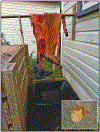Dead deer do tell tales: infestation of road-killed white-tailed deer by juvenile Ixodes scapularis (Ixodida: Ixodidae) ticks
- PMID: 40650528
- PMCID: PMC12351483
- DOI: 10.1093/jme/tjaf094
Dead deer do tell tales: infestation of road-killed white-tailed deer by juvenile Ixodes scapularis (Ixodida: Ixodidae) ticks
Abstract
The white-tailed deer (Odocoileus virginianus) contributes indirectly to the enzootic circulation of the Lyme disease pathogen, Borrelia burgdorferi by serving as the primary reproductive host for adult-stage blacklegged ticks (Ixodes scapularis). The role of white-tailed deer as a host for juvenile life stages is less well understood, in part because their periods of activity typically fall outside of most white-tailed deer hunting seasons. We inspected 22 road-killed deer for all stages of blacklegged ticks in Rutland County, Vermont from May to August in 2020, 2021, and 2024. Adult-stage blacklegged ticks were found attached to ten deer in May and early June. Larval-stage ticks, including ones that were partially engorged, were found on 3/5 deer inspected by hanging the head, hide, and legs over water for approximately 24 hours. We directly observed 7 nymphal-stage ticks attached to one additional deer. This study adds to a growing body of evidence that the role of juvenile feeding on white-tailed deer may be underestimated and demonstrates that the study of road-killed deer may improve our understanding of how populations of blacklegged ticks are maintained among wildlife communities.
Keywords: Ixodes scapularis; Odocoileus virginianus; feeding behavior.
© The Author(s) 2025. Published by Oxford University Press on behalf of Entomological Society of America. All rights reserved. For commercial re-use, please contact reprints@oup.com for reprints and translation rights for reprints. All other permissions can be obtained through our RightsLink service via the Permissions link on the article page on our site—for further information please contact journals.permissions@oup.com.
Figures



Similar articles
-
Lake Michigan insights from island studies: the roles of chipmunks and coyotes in maintaining Ixodes scapularis and Borrelia burgdorferi in the absence of white-tailed deer.Ticks Tick Borne Dis. 2021 Sep;12(5):101761. doi: 10.1016/j.ttbdis.2021.101761. Epub 2021 Jun 6. Ticks Tick Borne Dis. 2021. PMID: 34167044 Free PMC article.
-
Human pathogens associated with the blacklegged tick Ixodes scapularis: a systematic review.Parasit Vectors. 2016 May 5;9:265. doi: 10.1186/s13071-016-1529-y. Parasit Vectors. 2016. PMID: 27151067 Free PMC article.
-
The impact of deer exclusion fencing on host-seeking blacklegged ticks on suburban residential properties in southern New England.J Med Entomol. 2025 Jun 21:tjaf070. doi: 10.1093/jme/tjaf070. Online ahead of print. J Med Entomol. 2025. PMID: 40580545
-
PREVALENCE OF EHRLICHIA AND ANAPLASMA SPP. IN TICKS COLLECTED FROM CATTLE AND DEER IN ARKANSAS, USA.J Parasitol. 2023 Oct 1;109(5):530-536. doi: 10.1645/23-53. J Parasitol. 2023. PMID: 37903502 Free PMC article.
-
Factors that influence parents' and informal caregivers' views and practices regarding routine childhood vaccination: a qualitative evidence synthesis.Cochrane Database Syst Rev. 2021 Oct 27;10(10):CD013265. doi: 10.1002/14651858.CD013265.pub2. Cochrane Database Syst Rev. 2021. PMID: 34706066 Free PMC article.
References
Grants and funding
LinkOut - more resources
Full Text Sources

